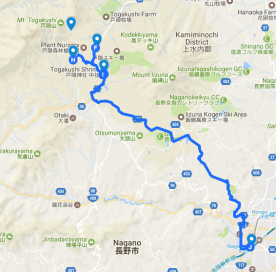written by Robert
Togakushi is an ancient village located in a mountain highland north of downtown Nagano City. Long an independent village, it, along with a handful of other villages in the area, was merged into Nagano City in 2005. Togakushi is best known for its five Shinto shrines, heavily visited by worshippers and tourists alike, for the breathtakingly beautiful pond Kagami-ike, for the famous Ninja Village, and for its delicious soba noodles found at a number of local restaurants. Traveling to Togakushi is a journey back to a Japan of the past, to a place with a relaxed lifestyle surrounded by the beauty of Myoko-Togakushi Renzan National Park. Though within the Nagano City limits, Togakushi is a world away from the hustle and bustle of the city, and is just a short bus ride from Nagano Station. Long-time resident of Togakushi, Robert, explains.
(Togakushi, Nagano City, population 1,070.)
Day 1
- 10:00
- Arrival / Nagano Station [1] in the map below
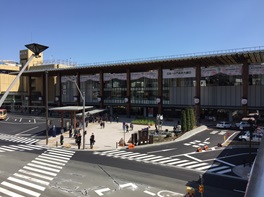
Nagano Station is the main arrival and departure point for the entire northern area of Nagano Prefecture. It is a mere 90-minute trip by Shinkansen from Tokyo, and three hours by limited express train from Nagoya. From Nagano Station, visitors to Togakushi can take a bus or a taxi. Taxis are available at the taxi stand just outside the station entrance. Buses to Togakushi are located at bus stop #7 opposite the station. The ride by bus to Togakushi takes approximately one hour, depending on which area of the village you plan on visiting.
- 11:00
- Hotel (Luggage Drop-Off) / Nakatani Ryokan 中谷旅館 / [2]
Togakushi has a number of Traditional Japanese inns, minshuku and hotels to choose 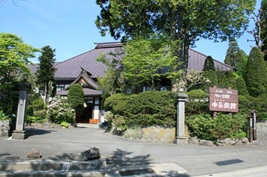 from. Being an old Japanese village steeped in tradition, the largest selection of accommodation is ryokan. Nakatani Ryokan is conveniently located right by the large torii gate of Togakushi Chusha Shrine. Get off the bus at the Togakushi Chusha bus stop and the ryokan is right across the street. Nakatani Ryokan is operated by a shinto priest and family for over a century, offering the kind of hospitality one would get staying with a family in their home from check-in to check-out. Once you have checked in, walk across the street for…
from. Being an old Japanese village steeped in tradition, the largest selection of accommodation is ryokan. Nakatani Ryokan is conveniently located right by the large torii gate of Togakushi Chusha Shrine. Get off the bus at the Togakushi Chusha bus stop and the ryokan is right across the street. Nakatani Ryokan is operated by a shinto priest and family for over a century, offering the kind of hospitality one would get staying with a family in their home from check-in to check-out. Once you have checked in, walk across the street for…
- 11:30
- Lunch at Uzuraya 蕎麦処 うずら家 / [3]
Uzuraya is arguably the best soba in Togakushi, if not all of Nagano. This well-known 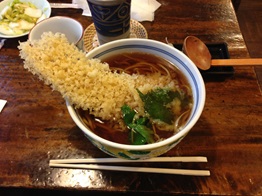 establishment, located right across the road from the Togakushi Chusha Shrine, beside a 700-year-old cedar tree, is first come first served, and you should expect to have to wait a bit. The wait is worth it, however. Lunch at Uzuraya is delicious! You will be given fresh wasabi with a grater to grate yourself. If you order tempura soba, the tempura will be so crispy you will almost not want to touch it. It is almost a work of visual art, but do eat it! The taste lives up fully to its appearance. Ordering food here is easy to do, with menus in several languages. The owner takes pride in having studied up on basic phrases and sentences in several languages, all to help ease his customers’ visit.
establishment, located right across the road from the Togakushi Chusha Shrine, beside a 700-year-old cedar tree, is first come first served, and you should expect to have to wait a bit. The wait is worth it, however. Lunch at Uzuraya is delicious! You will be given fresh wasabi with a grater to grate yourself. If you order tempura soba, the tempura will be so crispy you will almost not want to touch it. It is almost a work of visual art, but do eat it! The taste lives up fully to its appearance. Ordering food here is easy to do, with menus in several languages. The owner takes pride in having studied up on basic phrases and sentences in several languages, all to help ease his customers’ visit.
- 12:30
- Visit to Togakushi Chusha shrine 戸隠中社 / [4]
The large torii gate is easily noticeable and it welcomes the visitor to climb the steps up to 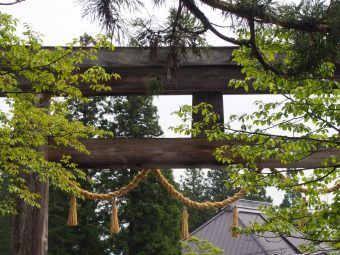 Chusha Shrine. Before heading up, look around. There are two cedar trees aged over 700 years old within view — both on either side of the torii. As you head up the steps to the shrine you will see more cedar trees, somewhat younger, yet an impressive 400 years in age. Togakushi Chusha enshrines the Shinto god of wisdom and believers regularly visit here to worship. All are welcome, though, and it is a good place to stop before heading on to the real attraction of the area…
Chusha Shrine. Before heading up, look around. There are two cedar trees aged over 700 years old within view — both on either side of the torii. As you head up the steps to the shrine you will see more cedar trees, somewhat younger, yet an impressive 400 years in age. Togakushi Chusha enshrines the Shinto god of wisdom and believers regularly visit here to worship. All are welcome, though, and it is a good place to stop before heading on to the real attraction of the area…
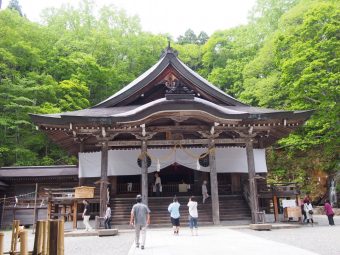
Chuusha’s main hall
- 13:00
- Visit to Togakushi Okusha shrine 戸隠奥社 / [5]
From Chusha shrine, hop on the bus for about five minutes out to the Okusha Iriguchi bus stop. Here you will find the entrance to the main attraction of Togakushi, Okusha shrine.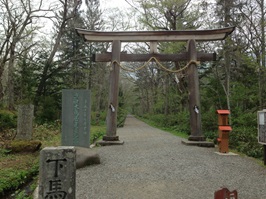 Expect crowds of tourists to be here, many arriving on tour buses. Okusha is known as a “power spot” and people in droves visit during the warmer seasons of the year.
Expect crowds of tourists to be here, many arriving on tour buses. Okusha is known as a “power spot” and people in droves visit during the warmer seasons of the year.
Once off the bus, head downhill from the road and you will see the torii gate which marks the start of the straight walking path to the shrine. Though it is a 2 km walk to Okusha shrine, it is at the halfway point that you will see the real reason for visiting this place. Here the walk is lined with dozens of 400-year-old cedar trees, with a single thatch roof gateway spanning the road.
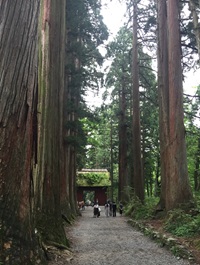 Standing among these majestic trees, it is no wonder this area is regarded as a power spot. Note how some of the trees have hallows in them large enough for an adult to enter.
Standing among these majestic trees, it is no wonder this area is regarded as a power spot. Note how some of the trees have hallows in them large enough for an adult to enter.
Continuing up the road, it becomes less straight and considerably steeper, with stone steps leading finally up to Okusha Shrine and the adjacent Kuzuryusha Shrine. Okusha Shrine is half concealed in a cave on the side of the mountain range behind it. While this shrine is not exactly a spectacular conclusion to the journey, it is really the journey itself that is why you came out here.
When ready, return the way you came.
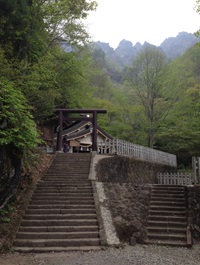
Okusha’s main hall.
- 15:30
- Visit to Togakushi Ninja Center 戸隠民俗館 / [6]
Across the street from the Okusha Shrine entrance, and slightly uphill surrounded by trees, is the Togakushi Ninja Museum. This place is actually a compound of old buildings 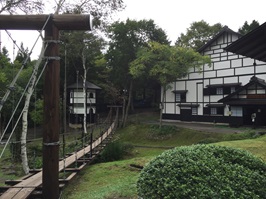 housing the Togakushi Folk Museum, Ninja Museum and Trick House. The folk museum features artifacts and displays which show the traditional tools, clothing and typical possessions of residents of old Togakushi, long before the modern world arrived. Uphill from the Folk Museum is the Ninja Museum, displaying tools and weapons used by the ninja who once secretly trained in this area, as well as photos and illustrations of ninja using these items. But the biggest draw here is the Trick House. This structure is literally a maze in which visitors must find their way from room to room, utilizing secret passages which must be found before passing through. The climax of the visit is an enormous room built deliberately at a steep angle. Try not to get dizzy or disoriented in that room.
housing the Togakushi Folk Museum, Ninja Museum and Trick House. The folk museum features artifacts and displays which show the traditional tools, clothing and typical possessions of residents of old Togakushi, long before the modern world arrived. Uphill from the Folk Museum is the Ninja Museum, displaying tools and weapons used by the ninja who once secretly trained in this area, as well as photos and illustrations of ninja using these items. But the biggest draw here is the Trick House. This structure is literally a maze in which visitors must find their way from room to room, utilizing secret passages which must be found before passing through. The climax of the visit is an enormous room built deliberately at a steep angle. Try not to get dizzy or disoriented in that room.
Before heading back to the bus, be sure to stop by the small cafe on site. It is very charming and is a wonderful spot for tea or coffee.
- 17:00
- Return to Nakatani Ryokan for dinner and evening stroll / [2]
Dinner at Nakatani Ryokan is a traditional Japanese meal, prepared by the family operating the inn. Your meal will be served in small dishes arranged in an orderly manner on the table in front of you. After dinner, take a relaxing bath in the ryokan’s communal bathroom. While not an onsen hot spring bath, the water will feel nearly as soothing after a long day of walking around.
After your bath, put on a yukata and some geta and take a stroll outside in the cool evening air.
Day 2
- 08:30
- Breakfast at Nakatani Ryokan [2]
Breakfast in a Japanese ryokan is similar to dinner, served in small dishes and is a great start to a new day. Once finished with your breakfast, it is off to another beautiful scenic spot in Togakushi.
.![]()
- 09:30
- Bus and walk to Kagami-ike 鏡池 / [7]
After breakfast, hop on the same bus you rode yesterday and head a few minutes up the road to Soba-no-mi restaurant. From here you walk along a narrow paved road through the 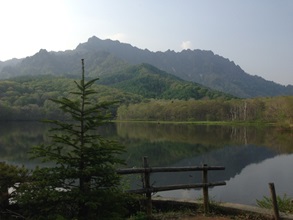 woods for 2 km to the breathtakingly beautiful Kagami-ike, which translates as “Mirror Lake.” The reason is obvious when you arrive. The lake is typically calm as glass, offering a stunning reflection of the mountains beyond. While you are here, stop by at Donguri House restaurant for coffee and cake, or perhaps take a stroll around the lake. Mostly a forested walk on wooden planks or raised boardwalks, it is an easy and pleasant time with occasional views of the lake or the mountains.
woods for 2 km to the breathtakingly beautiful Kagami-ike, which translates as “Mirror Lake.” The reason is obvious when you arrive. The lake is typically calm as glass, offering a stunning reflection of the mountains beyond. While you are here, stop by at Donguri House restaurant for coffee and cake, or perhaps take a stroll around the lake. Mostly a forested walk on wooden planks or raised boardwalks, it is an easy and pleasant time with occasional views of the lake or the mountains.
Return to the bus stop the way you came.
- 12:00
- Return back down to Nagano Station / [1]
After a nice walk to Kagami-ike, it is time to take the bus back to the city. If you have left your luggage at Nakatani Ryokan, be sure to stop there to get it!
OPTIONS
There is so much more to do in Togakushi than what can be listed here, but for those who are more adventurous, here are some suggestions.
Take a car or taxi in and around Togakushi. While the bus is cheap and convenient enough, a car or taxi will get you there much faster, offering more time to see other places.
If you are traveling with children, make a visit to the Ninja Village, an attraction similar to the Ninja Museum listed here, but more geared toward children. The Ninja Village is near Chusha Shrine and can be reached by the same bus.
If Uzuruya is crowded or they have exhausted their supply of soba for the day, consider going to Yamaguchi-ya just down the hill a bit.
Hikers with considerable experience should try climbing Mt. Togakushi. The trailhead is behind the residence next to Okusha Shrine. This hike is rather treacherous, with near vertical climbs on rocks with chains for assistance. The panoramic view from the top is spectacular, as is the ridge line trek that takes you down the other side of the range to the Togakushi Ranch and campsite. From there you can take the bus back to Okusha Iriguchi or any other stop in Togakushi Village.

